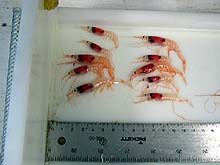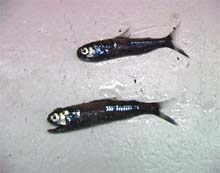
These shrimp belong to the Sergestidae family, which are generally found in the mesopelagic zone, located roughly 200 m below the ocean surface. Larger predators, such as fish and squid, feed on them. Click image for larger view.

Lanternfish are a mesopelagic species that migrate from deep midwater (800-1,000 m) to shallower depths (200 - 300 m) at night. This is when they feed and avoid predation from larger species, and return back to the deep midwater during the day. Lanternfish are among the most abundant and diverse of all oceanic fish families. Click image for larger view.
Midwater Mysteries at 'The Point'
September 20, 2001
Dr. John V. (Jack) Gartner, Jr.
Associate Professor
Natural Science Department
St. Petersburg College
St. Petersburg, FL
Dr. Steve Ross
North Carolina Estuarine Research Reserve Wilmington, NC
Dr. Ken Sulak
National Biological Survey
Gainesville, FL
Most of the daily logs deal with the habitat and animals on the ocean bottom. This one will take you to a slightly different world, that of the deep ocean waters that lie above these bottom habitats, but beneath the familiar surface waters populated by whales, dolphins, tuna, sea turtles, and other familiar ocean inhabitants. We have frequently collaborated on these bottom survey cruises using the Johnson Sea-Link because of the excellent opportunities to observe the open waters on the way to the bottom and back to the surface.
The region that we study forms the link between the ocean's surface and the bottom. In fact, these "midwater" depths, ranging from 200 m (660 ft) to the very bottom of the ocean trenches (more than 11,000 m, or almost 7 mi) form the largest ecosystems on Earth! It has been estimated from trawl catches that the abundance of a species in the fish genus Cyclothone, which are small (usually < 50 ml, or 2 in), flabby fish with tiny eyes, large mouths, and bead-like, luminescent organs along their flanks, outnumber any other vertebrate animal.
The midwater realm is more than just and obvious physical "link," however. We believe that it is also the major route for energy exchange between the ocean's surface and its depths, and that this exchange occurs in both upward and downward directions.
Three Deep-sea Zones
Deep-sea biologists typically divide this vast living space into three vertical zones. The mesopelagic zone (meso = middle; pelagic = living in open water) is the shallowest, ranging from about 200 to 1,000 m depth. Over this depth range, natural sunlight dwindles to total darkness. The Johnson Sea-Link submersible can traverse within this entire range. To our eyes, the outside waters appear totally dark by about 450-550 m, but to the inhabitants, whose special adaptations include extremely light-sensitive eyes, sunlight can be perceived to about 1,000 m in the clearest ocean waters.
The bathypelagic zone (bathy = deep) encompasses depths below the mesopelagic to about 4,000 m, or the upper edges of most ocean trenches. The waters here are uniformly cold, with extreme pressure and no natural sunlight whatsoever. The only light found here is produced by bioluminescence from the living inhabitants. Very few submersibles are capable of descending into this zone, so most of what we know about the bathypelagic comes from samples collected by nets.
The deepest zone, called the hadopelagic zone (hado is derived from the word Hades, the ancient Greeks' mythological underworld ), encompasses the waters within ocean trenches, and has been poorly studied to date.
Midwater Research
The midwater component of our research, both during this cruise and for many years prior, has focused on the mesopelagic zone. These are the depths that we can simultaneously sample by trawl and view using the submersible, and we believe that the inhabitants of this zone are crucial to the movement of energy from the rich, shallow ocean waters above 200 m to the ocean floor, especially along the continental slopes of the world's oceans.
A number of different trawl designs can be used to collect midwater animals. We use a fairly simple one, called an "opening-closing Tucker trawl." This net can be sent down to a specific depth, opened, and fished, closed, and then returned to the surface. Round-the-clock sampling allows us to develop a fairly accurate picture of where different organisms live during the day and night. Through the use of these nets and other sampling apparatus, we now know that many species of midwater animals, including fish, shrimp, and gelatinous organisms such as jellyfish and comb jellies, perform what we call "diel vertical migrations." This means that they typically reside in the lower mesopelagic zone (500-850 m) during the day, but swim upward to very shallow depths (less than 100 m, and sometimes even to the surface) at night. Most do this every single day and night. Since most of these animals are quite small (generally, the shrimp and fish average 60 m or less), their nightly excursion is the equivalent, distance-wise, of a 6-ft tall person running 25 mi twice a night, and completing each run in about 2 hrs!
One of the most abundant fish groups that we collect in the waters over the continental slope is the fish family Myctophidae. They are commonly known as lanternfish, and they are among the most abundant and diverse of all oceanic fish families. In appearance, they are quite similar to anchovies, with large heads, mouths, and eyes. As their name implies, they also bear numerous luminescent organs, the intesnity of which are under the nervous control of the fish.
We have observed and collected lanternfish, as well as other midwater animals, from the waters overlying some of the outer deep-reef regions. Many of the more inshore reefs studied in this program are too shallow for mesopelagic animals, however.
Few Species, but Swarms of Them, at 'The Point'
Historically, our trawl collections in the region of the western Atlantic known as "The Point" are unusual in several respects. First, we do not see the diversity of species we would normally expect in this region. In fact, only a few species account for almost all of the individuals collected. Second, one species of lanternfish is highly dominant in western Atlantic slope waters, but it is almost completely absent from our catches. Thus far, our collections on this cruise continue to reflect these unusual phenomena.
The Johnson Sea-Link has helped us to explain the second riddle, however. We have found that the "missing " species can often be located in vast swarms in very close proximity to the bottom, usually from less than 10 m to within mere inches of the bottom. When the sub enters these swarms, it is reminiscent of the photos and videos that show divers surrounded by huge schools of silvery herring or sardines. Around and within these large swarms are numerous other mesopelagic animals, including shrimp, eels, and several species of silver or brass-colored predatory fishes called "barracudinas." All of these are encountered in much greater numbers, and in a very different location, than our remote trawling data have indicated, which is testimony to the powerful observation platform that a submersible provides. The fishes' presence and behavior in these locations, and the resulting ecological implications, form the current focus of our research.
Sign up for the Ocean Explorer E-mail Update List.











































